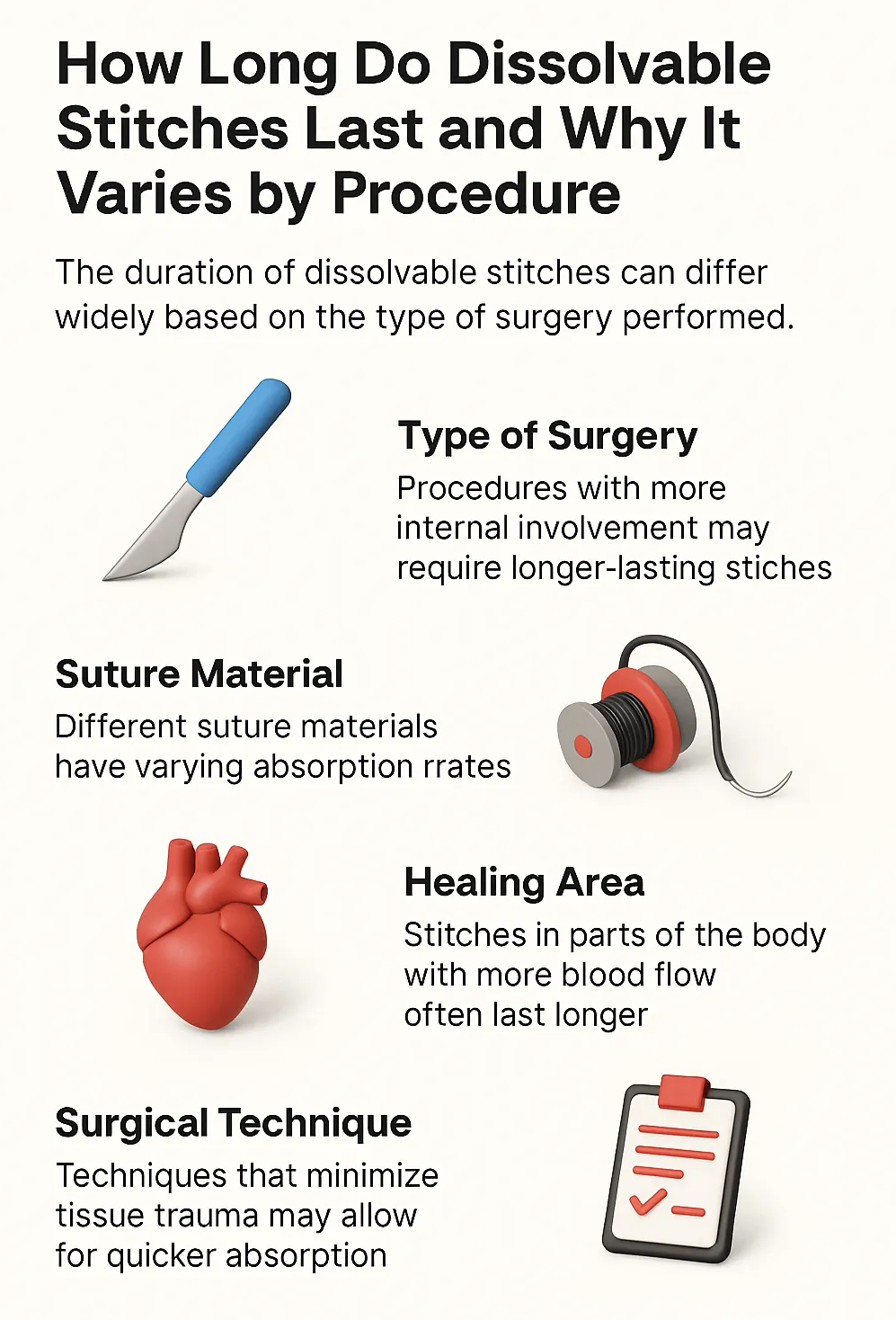How long do dissolvable stitches last? For patients recovering from surgery or injury, the answer is rarely a simple number. Based on clinical observations and post-surgery follow-ups, the lifespan of dissolvable stitches can be as short as a few days or extend to several months. The variation depends on the type of suture material used, the location of the wound, the body’s healing response, and how carefully the wound is cared for.
This guide explains the key reasons timelines vary, offers practical tips for smoother healing, and shares real-world examples of how different procedures can impact stitch longevity—answering the common question, how long do dissolvable stitches last while giving you the knowledge to better manage your recovery process.
Top Takeaways
- Stitches typically dissolve in 4–8 weeks, but the range can be days to months.
- Duration is affected by material type, wound location, movement, and aftercare.
- Careful aftercare prevents complications and supports faster healing.
- Absorbable sutures are proven as safe as non-absorbable for appropriate uses.
- Informed patients generally enjoy better recovery outcomes.
How Long Dissolvable Stitches Last and Why
Dissolvable stitches, also called absorbable sutures, are designed to break down naturally, eliminating the need for removal. Depending on the material and placement, they can last 7 days to 3 months.
- Fast-absorbing stitches (often used for surface closures) may dissolve within a week.
- Slow-absorbing sutures (used in deeper or high-tension areas) may remain intact for several weeks or longer.
Your body’s enzymes and immune system gradually absorb the material. Proper wound care—cleaning, protecting, and avoiding strain—can help the stitches perform their job effectively and dissolve as expected.
“From years of watching patients heal, it’s clear there’s no one-size-fits-all timeline for dissolvable stitches. The right material in the right place, combined with attentive aftercare, can mean the difference between a smooth recovery and setbacks, while also reducing the risk of complications like wоund dehiscence.”
Case Study & Real-World Examples
Rapid Absorption – Oral Surgery
- Patient: 34, post-wisdom tooth removal.
- Dissolved in ~7 days due to constant moisture and enzyme activity.
- Aftercare: Saltwater rinses and soft-food diet.
- Outcome: Quick healing with no irritation.
Moderate Duration – Sports Knee Surgery
- Patient: 48, active runner after knee arthroscopy.
- Stitches lasted ~6 weeks due to motion and mild swelling.
- Aftercare: Joint support taping and gradual activity return.
- Outcome: Protected wound, steady recovery.
Slow Absorption – Abdominal Repair
- Patient: 52, with polydioxanone (PDS) sutures.
- Strength retention for ~8 weeks, fully dissolved in ~3 months.
- Purpose: Long-term support for deep tissues.
- Aftercare: Strict cleaning and infection prevention.
Key Insight: Procedure type, wound location, and suture choice are major drivers in how long stitches last, and advancements in wound care technology now play a key role in optimizing healing times and outcomes
Supporting Statistics
- Safety Evidence: Absorbable sutures are as effective as non-absorbable in most cases (American Academy of Family Physicians).
Final Thought & Opinion
- Dissolvable stitches are not on a fixed schedule—they adapt to your body and your procedure.
- Some vanish in a week, others work for months.
- Patients who understand their healing process and follow aftercare diligently tend to recover more smoothly.
Next Steps
- Follow your provider’s wound-care plan.
- Watch for redness, swelling, pain, or discharge.
- Avoid pulling or removing stitches yourself.
- Maintain a healthy diet and hydration.
- Keep follow-up appointments.
- Learn from reputable medical sources.
Frequently Asked Questions
How long do dissolvable stitches usually last?
Most dissolve within 4–8 weeks, but the range can be as short as a few days or as long as several months, depending on the type of procedure and suture material used.
Why does the duration of dissolvable stitches vary?
Differences in suture type, wound location, patient activity level, and healing speed all influence how long stitches remain before dissolving.
Do certain procedures require longer-lasting dissolvable stitches?
Yes. Deep tissue repairs, abdominal surgeries, and joint surgeries often use slow-absorbing sutures for extra support, while minor skin closures may use fast-absorbing types.
What should I do if dissolvable stitches don’t seem to be dissolving?
If stitches remain beyond the expected timeframe or cause irritation, contact your healthcare provider. Never attempt to remove them yourself.
How can I help ensure my dissolvable stitches last the right amount of time?
Follow your aftercare plan, keep the wound clean, avoid unnecessary strain, and attend all follow-up appointments.
When exploring How Long Do Dissolvable Stitches Last and Why It Varies by Procedure, it’s helpful to consider the parallels between medical recovery and maintaining other essential systems in your life. Just as stitches require proper care to ensure they dissolve at the right pace, home systems also benefit from preventative measures. For example, ensuring a clean and efficient home environment with services like dryer vent cleaning in Keystone Heights, FL can help prevent hazards, much like careful wound management prevents complications. Similarly, improving your home’s efficiency through attic insulation installation mirrors how selecting the right suture material optimizes healing time. Even air quality plays a role in recovery, and high-performance products such as 16x32x1 Pleated Furnace Filters or 17x25x1 MERV 8 Pleated HVAC AC Furnace Air Filters – 3 Pack support cleaner air, which can aid in overall wellness. And for those looking for reliable deals, options like HVAC air filters on eBay can ensure you’re stocked up—just as having the right medical supplies can keep your healing on track.
